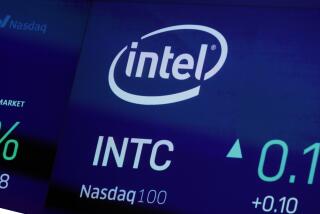Intel Halts Work on Pentium 4 Successor
- Share via
Intel Corp. said Friday that it was abruptly ending development of its next-generation personal computer chip and changing direction to go with a more promising design.
The Santa Clara, Calif., company scrapped its work on a chip code-named “Tejas” to focus on new desktop and laptop PC chips with dual cores, which allow additional computing power to be built in.
“It’s highly unusual for Intel to switch gears so publicly like this,” said Dan Hutcheson, head of VLSI Research, a technology market research company in San Jose. “Shutting down a major microprocessor development is a very big deal. You spend so much money bringing one of these processors to market that you seldom start until you know what’s going to work.”
The Tejas chip was intended to replace Intel’s flagship Pentium 4. Like the Pentium, it was to employ a technology called hyperthreading, which allows a chip to perform multiple computing tasks simultaneously.
In contrast, dual-core processors have two computing engines each. They had been due in 2006 but will be moved up to 2005 to take Tejas’ place, Intel spokeswoman Laura Anderson said.
“We’ve basically reprioritized our resources and shifted our roadmap,” Anderson said.
Design engineers who were working on Tejas and “Jayhawk,” its counterpart chip for server computers, will be reassigned to other projects. Anderson declined to say how many people were affected.
Analysts speculated that heat problems with Tejas contributed to its cancellation.
“When you make the transistor operate really fast, it will start to leak current, which causes power dissipation problems,” Hutcheson said. “When you add up millions of transistors, it gets to be as hot as a waffle iron.”
Intel would not say that heat was a problem.
“As you shrink products, heat becomes more challenging, but it hasn’t been a limiting factor,” Anderson said.
Shane Rau, a semiconductor analyst with technology market researcher IDC, said he had heard that trouble was brewing with Tejas about six months ago.
“I think they did see it coming,” Rau said. He added that it was his understanding that in recent months, as Intel continued to pursue Tejas, engineers also initiated a back-up plan of using the latest Pentium 4 as the foundation for the new chip.
The current Pentium is built with its smallest components only 90 nanometers wide, or 1/1,500 as wide as a human hair. Intel has said it will come out with even smaller chips, whose components are 65 nanometers wide, in late 2005.
Anderson would not say whether the new dual-core chips would be made with 90-nanometer or 65-nanometer technology.
Shares of Intel gained 49 cents Friday to $26.47 on Nasdaq.
More to Read
Inside the business of entertainment
The Wide Shot brings you news, analysis and insights on everything from streaming wars to production — and what it all means for the future.
You may occasionally receive promotional content from the Los Angeles Times.









